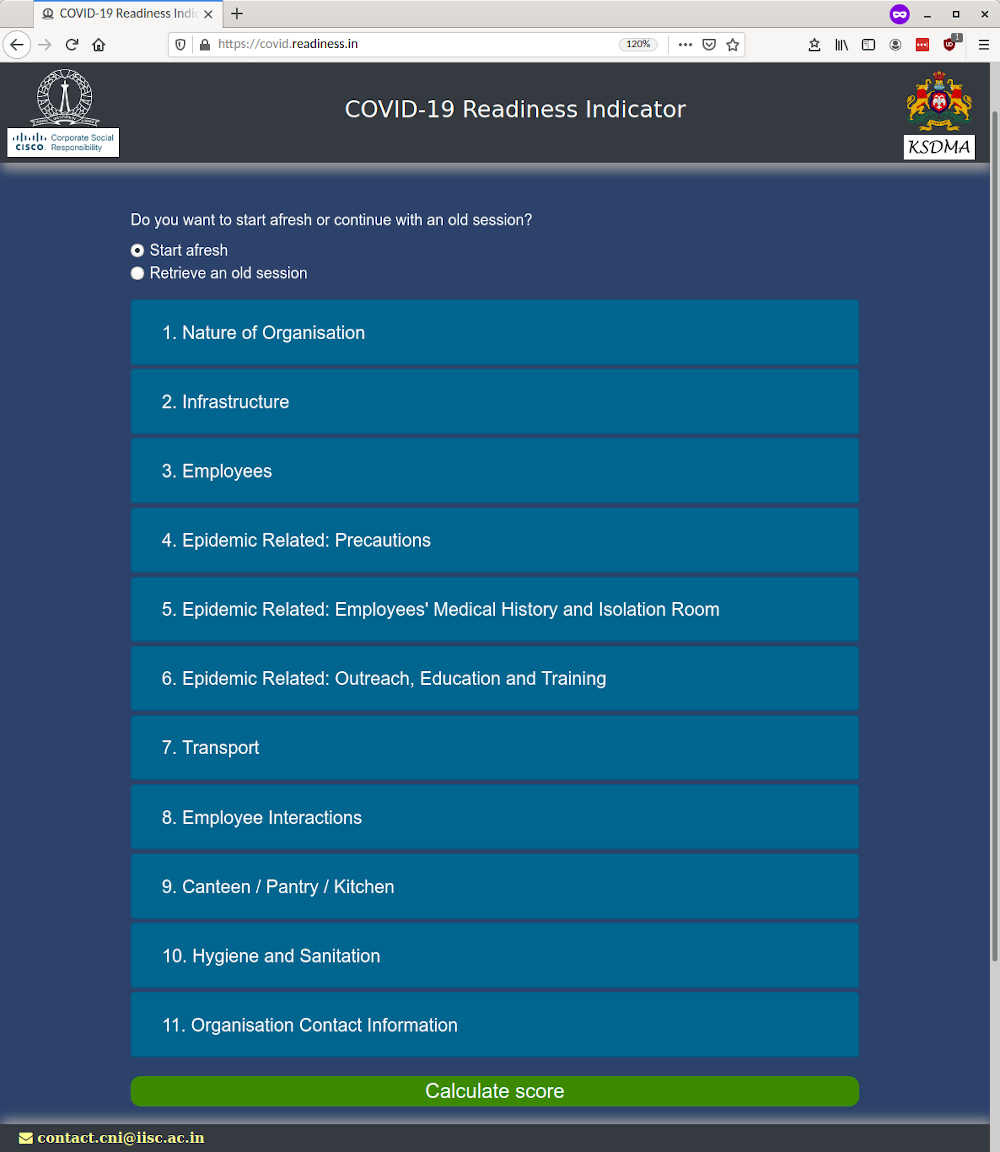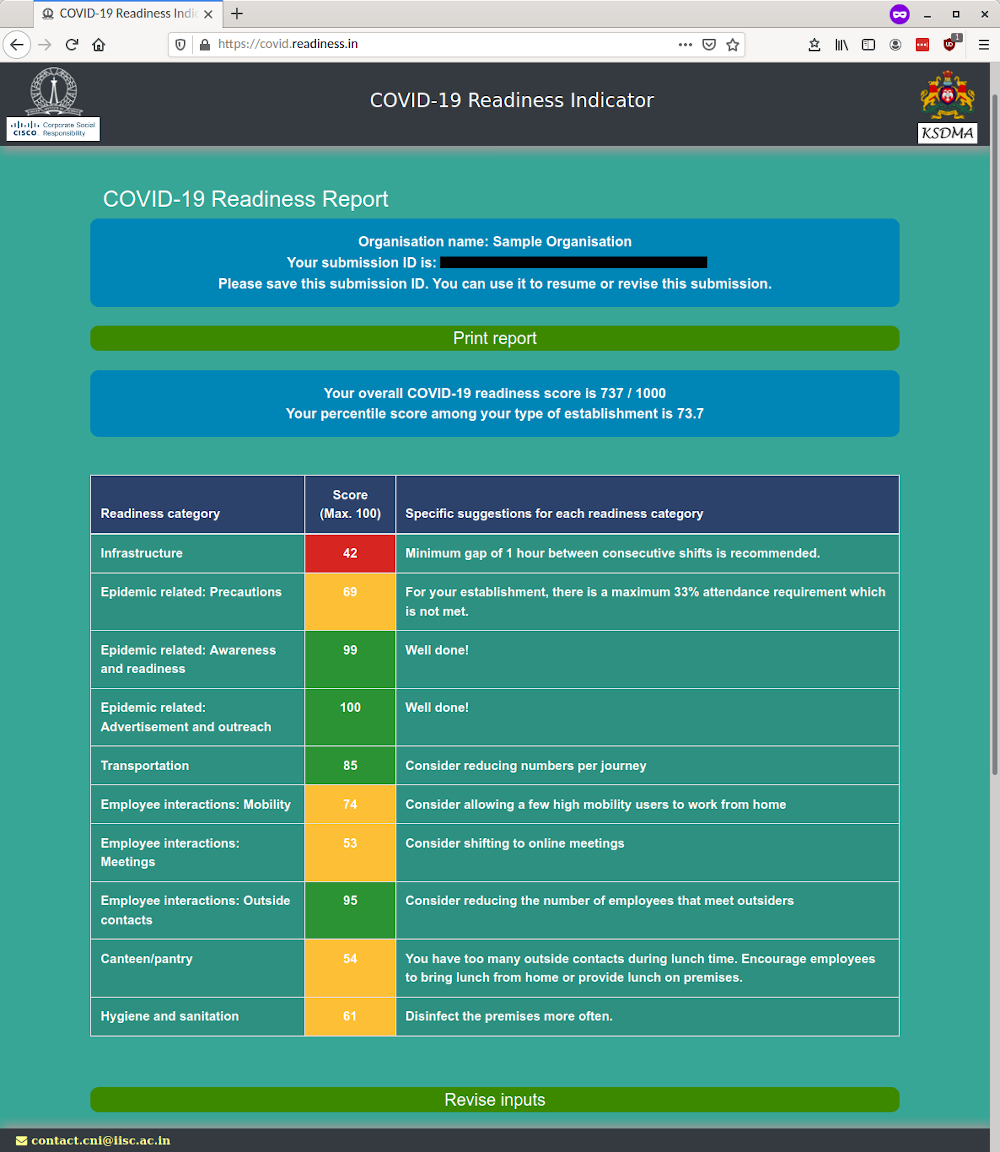- A covid19 readiness tracker has been launched to provide insights on organizations covid preparations
- This software scores your business based on various pandemic parameters such as shifts, employee benefits, safety cleanliness, social distancing, etc.
- The app shows how you fare in COVID preparedness and suggests areas and ways of improvement
- The app also compares your score with that of those of your peers making you realize your position in the market.
As the economy reopens and organizations get back to work everywhere in the world, a new dilemma arises. Many businesses and organizations are facing apprehensions from their workers and clients regarding COVID19 safety of the workplace. In such a situation, a COVID19 Readiness Tracker is an essential tool to ascertain your credibility, especially if it comes from a premier research institute like the Indian Institute of Science, IISc.
COVID19 Readiness Tracker
A latest press release from the Indian Institute of Science has announced that they are releasing an online self-assessment tool known as the COVID-19 Workplace Readiness Indicator has been developed by a team of IISc researchers, in collaboration with the Karnataka State Disaster Management Authority (KSDMA).
The tool was developed as part of research efforts at the new Centre for Networked Intelligence (CNI) established at IISc with generous support under Corporate Social Responsibility (CSR) from Cisco.
A Tool To Understand Your COVID Preparedness
As cities and businesses ease out of the lockdowns imposed due to the ongoing COVID-19 pandemic, workplaces need to effectively follow guidelines in order to ensure safety. The Workplace Readiness Indicator is an advisory tool that can enable organizations to understand their current level of preparedness and key risk areas. It will also help them plan and establish pandemic-specific policies, procedures, and necessary management practices.
“The tool not only scores an organisation’s readiness, but also provides some targeted suggestions if specific weaknesses are identified,”
-says Nihesh Rathod, a Cisco-IISc PhD scholar at the Department of Electrical Communication Engineering, IISc, who helped develop the tool.

The Government of Karnataka has recommended this advisory tool to various organizations in the state, as they begin operation in accordance with the Unlock-1 guidelines.
“The end of the lockdown does not automatically mean a return to the old ‘normal’ and the opening will take different shapes, with different regions and different business sectors opening up in different ways and at differing speeds,” says Manoj Rajan, Commissioner, KSDMA. “Organisations will need to take a holistic approach to restarting. Emerging from the lockdown, companies and workplaces will need to be more vigilant about health and increase their demands on safety.”

How does this work?
- The tool takes into account broad epidemic factors and social objectives, and suggests a simple readiness threshold that organisations need to meet or exceed in order to operate effectively, while managing their pandemic response.
- They can then decide for themselves their best mix (shifts, precautions taken, company advisories, etc.) to maximise their business objectives while adhering to this threshold.
How To Use It?
The tool is simple and easy to use.
- An organisation can enter relevant information about their workplace and their current level of operation.
- Readiness is calculated using ten specific indices, each with a maximum score of 100.
- These include infrastructure, precautions, outreach, employee interactions, transport, details of eateries, hygiene and sanitation.
- The overall readiness index is the sum of the ten individual readiness indices.
- The tool scores the organisation’s readiness across various categories and provides a consolidated report.
A Glimpse of Your Position Amongst Your Peers
The tool also shows the organisation’s percentile with respect to other similar organisations.
“Once enough organisations use the tool, each organisation can see where it stands among other organisations of the same kind. Such a comparison may induce organisations to be proactive and take more positive steps towards mitigating the pandemic,” says project lead Rajesh Sundaresan, Professor, Department of Electrical Communication Engineering, IISc.
Broader Aim of Decision Making
The tool is an outcome of a broader effort to develop mechanisms that enable better and decentralised decision making, an important goal of the Centre for Networked Intelligence.
“Over the last few months, every aspect of our world has been disrupted, prompting us to pivot to a new way of life very quickly,” says Krishna Sundaresan, Vice President, Engineering, Cisco India & SAARC.
“In the beginning, technology served as the greatest enabler of business continuity, as workforces across India turned remote. Now, as they return to office, technology is once again playing a significant role in ensuring employees’ safety, which is a top priority for any organization. In many ways, this pandemic has emphasized that people come first, and that we are better together. This crisis is much too complex for anyone to solve alone, and in partnership with IISc, we are committed to helping the industry emerge from it stronger.”
The readiness tool has been put together in a very short time to help organisations navigate operational difficulties. The researchers are continuing to work on improving the tool and its usage.
REFERENCE :
Web portal: https://covid.readiness.in
The software is open source and can be downloaded from github: https://github.com/cni-iisc/workplace-readiness
Full report: https://covid19.iisc.ac.in/wp-content/uploads/2020/06/Report-20200518-WorkplaceReadiness.pdf
CONTACT :
Rajesh Sundaresan
Professor, Department of Electrical Communication Engineering
Indian Institute of Science (IISc)
rajeshs@iisc.ac.in
+91-80-2293 2658
Did you subscribe to our daily newsletter?
It’s Free! Click here to Subscribe!
Source: IISc















